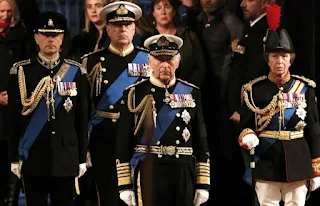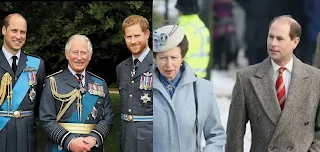Decades before he mounted the British throne, the then Prince of Wales was open to the idea of trimming down the monarchy and even suggested in a meeting with the Council of State that he would limit the number of working royals.
His reason was purely financial. The slim-down monarchy means cutting the budget and expenses from the Sovereign Grant (the government's budget given to the monarchy annually for performing public duties, including allowances for the working royals).
 |
| The King and his three younger siblings |
However, it is now reported that the newly ascended British monarch would not progress with his original plan of trimming down the monarchy. He will keep things as they are, royal experts said.
Royal expert, Richard Palmer, citing royal insider sources, said, the newly ascended king, has no plan to streamline the British monarchy in the foreseeable future. In the article published by The Express UK and The Daily Mail UK, it was reported that the king and his advisers have ruled out the possibility of cutting the number of working royals.
He said, "What has been made clear to me on behalf of the King, or those close to him, is that currently there is no plan to cut the number of working royals.”
So what made the king change his mind?
The sources did not elaborate on the reasons but perhaps because the House of Windsor has only a few working royals to support the reign of the king, after Prince Andrew and Prince Harry stepped back from public duties.
 |
| Surrounded by his two sons, William and Harry |
The children of Prince William, who are expected to take prominent royal roles in the future, are still very young. It would take one full decade before Prince George of Wales will turn 18 and become a working royal and member of the Council of State.While the king privately is still compassionate to his son, the Duke of Sussex, and to his younger brother, the Duke of York, after they stepped back from public life, there is no plan for them to be given prominent royal roles in the reign of the king while they are non-working royal family members.
 |
| Prince George, Prince Louis, and Princess Charlotte |
 |
| Charles and his two younger brothers during the wedding of Prince Edward in June 1999 |
So he will rely most on the support of the current 10 working royals, most especially from his two younger siblings, the Princess Royal and the Earl of Wessex. His heir, the Prince of Wales, will most likely increase his workload.
 |
| The Princess Royal and her younger brother, the Earl of Wessex |
Royal sources said the Prince and Princess of Wales are expected to increase their workload and take on new jobs, but the same royal insiders said that Catherine has made it clear she would prefer to look after her young children than expand his royal activities.
 |
| The Prince and Princess of Wales in Northern Ireland. Catherine made it clear she prefers to devote time to her young children than increase her royal activities according to royal insiders |
The Princess of Wales rarely takes solo engagements and has not been given a prominent public role to share the workloads of the king other than related to her previous advocacies on mental health and child care. The Duke and Duchess of Sussex are not expected to change their minds to rejoin the royal family as working members.
Thus, King Charles III will now increasingly lean on the support of his son and heir, the Prince of Wales, and his two younger siblings, Princess Anne and Prince Edward (with his wife, Sophie). It is expected also that the Duke and Duchess of Gloucester, Princess Alexandra, and her older brother, the Duke of Kent, will cut their royal activities due to their advanced age.
 |
Princess Anne and the king have always been closer since childhood
|
Here are the current working royals (and their age), apart from the king:
- Camilla, the Queen Consort (75) - wife of the king
- William, the Prince of Wales (40) - eldest son of the king
- Catherine, the Princess of Wales (40) - daughter-in-law of the king
- Anne, the Princess Royal (72) - younger sister of the king
- Prince Edward, the Earl of Wessex (58) - younger brother of the king
- Sophie, the Countess of Wessex (57) - sister-in-law of the king
- Prince Richard, the Duke of Gloucester (78) - uncle of the king
- Birgitte, the Duchess of Gloucester (76) - aunt-in-law of the king
- Princess Alexandra, the Hon. Lady Ogilvy (85) - aunt of the king
- Prince Edward, the Duke of Kent (87) - uncle of the king
 |
| Senior working royals from left: The Duke and Duchess of Gloucester, the Duke of Kent and Princess Alexandra |
The current members of the King's Council of State:
- Camilla, the Queen Consort (75) - wife of the king
- William, the Prince of Wales (40) - eldest son of the king (heir-apparent)
- Prince Harry, the Duke of Sussex (38) - younger son of the king (fifth in line to the throne)
- Prince Andrew, the Duke of York (62) - younger brother of the king (8th in line to the throne)
- Princess Beatrice, Mrs. Edoardo Mapelli-Mozzi (34) - niece of the king (9th in line to the throne)
 |
| The current Counselors of State of Charles III |
 |
| Royal family portrait: The Queen, Prince Philip, Duke of Edinburgh, and their four children |
The departure of the Duke and Duchess of Sussex, and the Duke of York, from royal roles, has put more strain on the king's workload to discharge his ceremonial duties to the state and the Commonwealth.
King Charles III will be crowned in May 2023, eight months after the death of his mother. The king wishes to have a simple coronation ceremony and be significantly shorter than the 1953 coronation of Queen Elizabeth II.
 |
| The King and his younger brother, Prince Andrew |
 |
| royal siblings: Princess Anne and Prince Edward |


















0 Comments